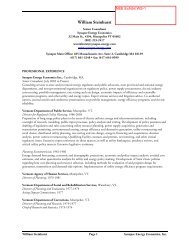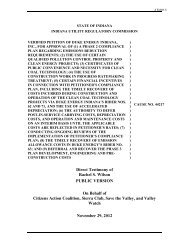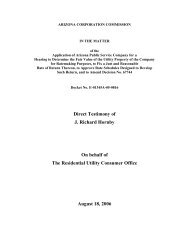Best Practices in Energy Efficiency Program Screening - Synapse ...
Best Practices in Energy Efficiency Program Screening - Synapse ...
Best Practices in Energy Efficiency Program Screening - Synapse ...
Create successful ePaper yourself
Turn your PDF publications into a flip-book with our unique Google optimized e-Paper software.
significant impacts that have important public policy implications, and are important <strong>in</strong><br />
plann<strong>in</strong>g energy efficiency programs, most notably the benefits to low-<strong>in</strong>come customers<br />
and the sav<strong>in</strong>gs associated with alternative fuels.<br />
The Participants test is fundamentally different from the other tests, <strong>in</strong> that it limits<br />
benefits to customer bill sav<strong>in</strong>gs as the primary benefit of the programs. Customer rates<br />
are typically higher than the marg<strong>in</strong>al avoided costs of the energy system, lead<strong>in</strong>g to<br />
higher energy efficiency benefits per unit of energy saved. Also, the only costs <strong>in</strong> this<br />
test are the customer costs, which <strong>in</strong> many cases are lower than the costs <strong>in</strong>curred by<br />
the program adm<strong>in</strong>istrator to plan, design, and deliver the energy efficiency programs.<br />
Consequently, this test is typically the least restrictive of all the other cost-effectiveness<br />
tests. As noted above, it provides an <strong>in</strong>dication of the distributional effects of the energy<br />
efficiency program, along with the RIM test, and may useful <strong>in</strong> optimiz<strong>in</strong>g program<br />
design for participation.<br />
The Rate Impact Measure test tends to be the most restrictive of all the efficiency tests,<br />
because the utility lost revenues can make very large contributions to the energy<br />
efficiency program costs. Most, if not all, states have ruled that the RIM test should not<br />
be used as the primary test for evaluat<strong>in</strong>g energy efficiency cost-effectiveness. There<br />
are several reasons for this.<br />
Apply<strong>in</strong>g the RIM test to screen efficiency programs will not result <strong>in</strong> the lowest<br />
cost to society or the lowest cost to customers on average. Instead, it will lead to<br />
the lowest rates (all else be<strong>in</strong>g equal). However, achiev<strong>in</strong>g the lowest rates is not<br />
the primary goal of utility plann<strong>in</strong>g and regulation, especially if lower rates lead to<br />
higher costs to customers on average.<br />
The RIM test is heavily <strong>in</strong>fluenced by the lost revenues to the utility. However,<br />
lost revenues are not a true cost to society. Lost revenues represent a "transfer<br />
payment" between efficiency program participants and non-participants; the bill<br />
sav<strong>in</strong>gs to the program participants result <strong>in</strong> the lost revenues that are collected<br />
from all customers, <strong>in</strong>clud<strong>in</strong>g non-participants.14 In this way, lost revenues are<br />
not a new or an <strong>in</strong>cremental cost <strong>in</strong> the same way that the program<br />
adm<strong>in</strong>istration costs are a new and <strong>in</strong>cremental cost of implement<strong>in</strong>g energy<br />
efficiency programs, and they should not be applied as such <strong>in</strong> screen<strong>in</strong>g a new<br />
energy efficiency resource.<br />
A strict application of the RIM test can result <strong>in</strong> the rejection of large amounts of<br />
energy sav<strong>in</strong>gs and the opportunity for large reductions <strong>in</strong> many customers’ bills<br />
<strong>in</strong> order to avoid what are often small impacts on non-participants’ bills. From a<br />
public policy perspective, such a trade-off is illogical and <strong>in</strong>appropriate.<br />
The RIM test does not provide useful <strong>in</strong>formation about what happens to rates as<br />
a result of program implementation. A RIM test benefit-cost ratio of less than one<br />
<strong>in</strong>dicates that rates will <strong>in</strong>crease (all else be<strong>in</strong>g equal), but says little to noth<strong>in</strong>g<br />
about the magnitude of the rate impact. And it says noth<strong>in</strong>g at all about the<br />
amount of cost sav<strong>in</strong>gs associated with the energy efficiency.<br />
14 Note that <strong>in</strong> those jurisdictions where utilities are not allowed to collect lost revenues and do not have<br />
decoupl<strong>in</strong>g, for those years <strong>in</strong> between rate cases this transfer payment is actually between the utility<br />
shareholders and program participants.<br />
| 16 <strong>Best</strong> <strong>Practices</strong> <strong>in</strong> <strong>Energy</strong> <strong>Efficiency</strong> <strong>Program</strong> Screen<strong>in</strong>g | www.nhpci.org







